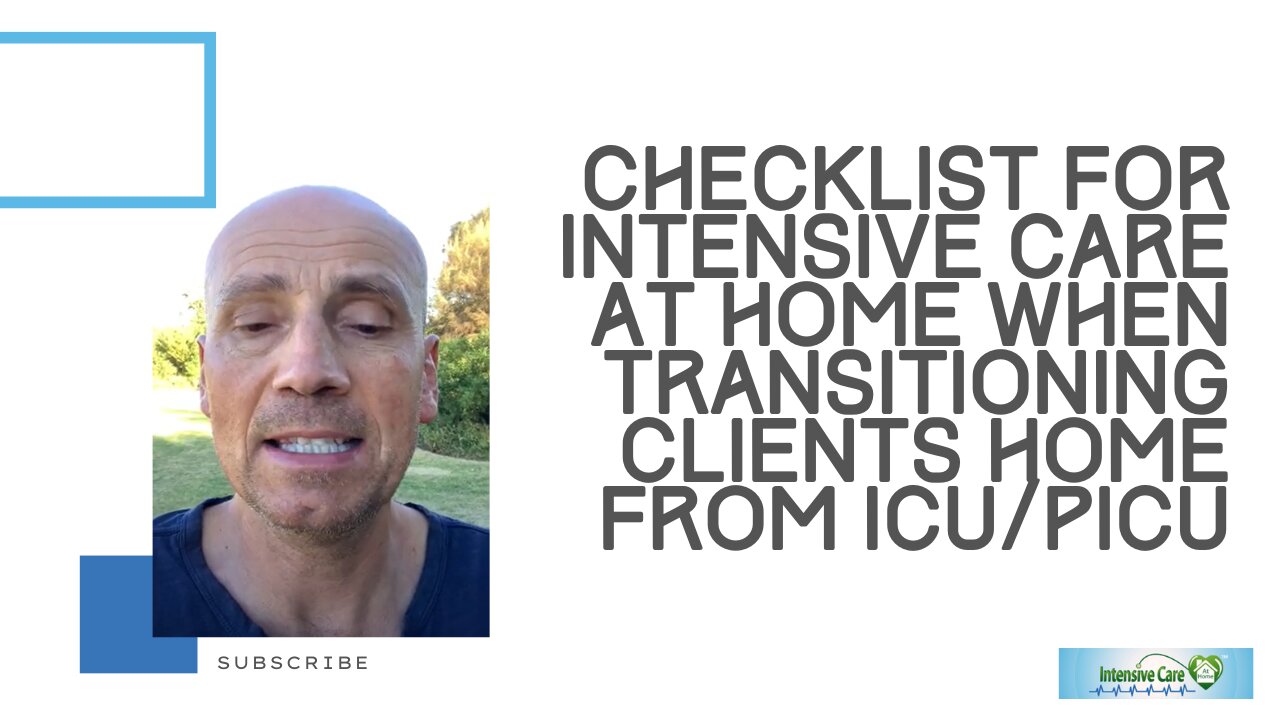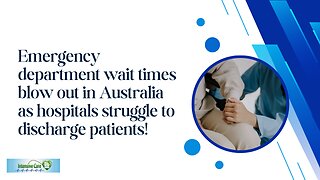Premium Only Content

Checklist for Intensive Care at Home When Transitioning Clients Home from ICU/PICU
Checklist for Intensive Care at Home When Transitioning Clients Home from ICU/PICU
Book your free 15-minute phone consultation here
http://intensivecarehotline.com/scheduling-appointment/
Call directly 24/7
+1 415-915-0090 USA/Canada
+44 118 324 3018 UK
+6141 094 2230 Australia
Email support@intensivecarehotline.com
Get 1:1 consulting and advocacy
1:1 phone counselling
http://intensivecarehotline.com/one-on-one-counselling/
Become a member for families of critically ill Patients in Intensive Care
https://intensivecarehotline.com/intensivecaresupport-org-membership/
Immediate action steps http://intensivecarehotline.com/take-control-take-charge/immediate-action-steps/
https://intensivecareathome.com
And if you need a medical record review, click on the link and we can help you with reviewing your loved one’s medical records while they’re in ICU.
https://intensivecarehotline.thrivecart.com/review-of-medical-records/
Facebook Page: https://www.facebook.com/IntensiveCareHotline
Twitter: https://twitter.com/icuhotline
Hi, it’s Patrik Hutzel from Intensive Care at Home, where we provide tailor-made solutions for long-term ventilated adults and children with tracheostomies and where we also provide tailor-made solutions for BIPAP and CPAP dependent adults and children on non-invasive ventilation, as well as home TPN and otherwise medically complex patients, and we provide a genuine alternative to a long-term stay in intensive care.
So today, I want to talk about a client that is inquiring about our service and asking, “What’s our checklist when we onboard clients to go home from intensive care?” And of course, we have a checklist when we onboard clients so they can go home from intensive care. And I’ll quickly go through the checklist so that you have an idea how we approach it.
Obviously, there’s a list of equipment that we need to go through, especially when it comes to mechanical ventilation. There are usually two ventilators needed. There are two suction units needed. There are spare tracheostomies needed, assuming a client of ours is ventilated with a tracheostomy. If they are non-invasively ventilated like BIPAP or CPAP, they don’t need spare tracheostomy equipment, but they still need two ventilators. They also often need the suction machine. Definitely, clients with tracheostomy and ventilation need a suction machine. Most clients with BIPAP and CPAP that are under our care need suction machines as well.
Obviously, they need resuscitation bags. If they’re having a tracheostomy, they need two different sizes. If they’re, for example, having a size 8 tracheostomy, they need also a size 7 tracheostomy as backup. They need a resuscitation bag with a PEEP valve and a resuscitation mask. They need oxygen cylinders or an oxygen concentrator, oxygen tubing, nebulizer set humidifiers.
If they’re having a PEG (percutaneous endoscopic gastrostomy) tube or a nasogastric tube, they need a feeding pump, enteral feeding giving sets. They need dressings for the tracheostomy. They need dressings for the PEG tube. Gloves, of course. Sometimes sterile gloves, especially when it comes to tracheostomy dressing changes. Goggles for the staff. Normal saline ampoules, chlorhexidine, as well as a tablet crusher most of the time with a bladder syringe as well.
A urine bag if clients have a suprapubic catheter or sometimes even an indwelling catheter. And the list goes on such as stethoscope, blood pressure cuff, monitor, of course, to monitor heart rate and oxygen saturation. Often a special care bed, a hoist lifting machine is needed. Ideally a ceiling hoist, especially when it comes to long-term patients. Tracheal dilator and so forth.
Now, also comes down to that a 24-hour nursing roster with intensive care nurses is in place. A care and activity plan, clinical observation charts, ventilation charts, standard shift check charts, and all of our clinical documentation needs to be in place as well before we can safely take a patient home from intensive care. But it’s absolutely doable. We have done it many times.
And if you are in a situation where your loved one is stuck in an intensive care bed, long term with ventilation or tracheostomy or any of the other situations that I’ve just mentioned, if they’re on BIPAP or CPAP and they can’t leave intensive care, or sometimes patients are stuck on a respiratory ward or floor as well and they can’t live there. Or sometimes patients are stuck on a hospital floor with a tracheostomy, and they can’t go home because no one in the community can look after them. Then, you should contact us as well.
Continuation...
https://intensivecareathome.com/checklist-for-intensive-care-at-home-when-transitioning-clients-home-from-icu-picu/
-
 24:44
24:44
Intensive Care at Home
16 days agoEmergency Department Wait Times Blow Out in Australia as Hospitals Struggle to Discharge Patients!
51 -
 LIVE
LIVE
Randi Hipper
40 minutes agoBITCOIN AT CRITICAL LEVELS AS MARKET CRASHES! LATEST PRICE UPDATE HERE
349 watching -
 LIVE
LIVE
Matt Kohrs
9 hours agoMARKET CRASH! Trump's Trade War Bloodbath || The MK Show
2,368 watching -
 1:16:40
1:16:40
Graham Allen
2 hours agoCanada WILL LOSE!! Trudeau Enters Trade War With The US! + Zelensky Is Missing 102 BILLION?!
15.4K31 -
 59:17
59:17
Kyle Fortch
1 hour agoJon Kilmer: Touring With Kendrick Lamar, Steve Aoki & mike, Creating A Brand | THE ONE SHEET S1E2
11 -
 38:34
38:34
BonginoReport
4 hours agoTrump Obliterates USAID—the CIA's Piggy Bank (Ep.131) - 02/03/2025
24.7K84 -
 LIVE
LIVE
Wendy Bell Radio
5 hours agoBeware The Wrath Of A Patient Man
13,990 watching -
 1:23:17
1:23:17
Game On!
11 hours ago $0.33 earnedHappy Super Bowl Week! Our Top 10 Super Bowl Props to Bet!
3K1 -
 LIVE
LIVE
Jeff Ahern
2 hours agoMonday Madness with Jeff Ahern (6am pacific)
576 watching -
 LIVE
LIVE
SoniCentric
2 days agoSoothing Autumn River Coffee Shop with Relaxing Jazz
246 watching